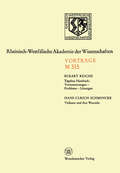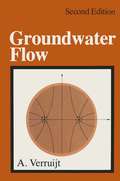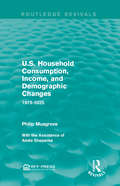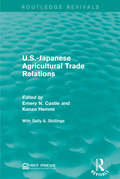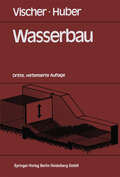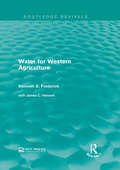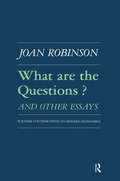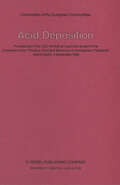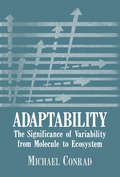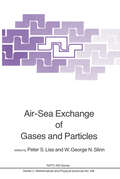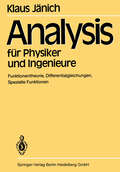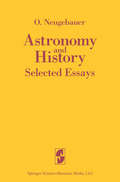- Table View
- List View
The Stratospheric Aerosol Layer (Topics in Current Physics #28)
by R. C. WhittenIt is now a quarter of a century since Junge and his coworkers recovered the first sample from the sulfate aerosol layer in the stratosphere. Since that time vast strides have been made in determining its physical properties and morphology. These investigations have been performed with instruments on board aircraft and balloon platforms as in the early days, with ground-based lidar (optical radar), and most recently with satellite-borne optical instruments. It will become evident in Chapter 2 that in situ measurements by aircI'aft and ,balloon sensors complement rather than duplicate the remote techniques (lidar and satellite). Hence future programs will probably continue to utilize direct as well as indirect experimental techniques. Concurrently, with the observations of the gross properties of the aerosol layer, la~oratory and theoretical studies have sought to elucidate the chemical and micro physical processes which influence the formation and growth of the aerosol par ticles. The laboratory investigations have included studies of gas phase chemistry, and particle nucleation and growth mechanisms. Theoretical studies have revolved mainly around a series of models developed by atmospheric scientists. The earliest of these models was constructed by Junge and his colleagues. With the advent of third- and fourth-generation computers, the capacity to solve the quite complex continuity equations whi~h govern particle formation, growth, and removal has ad vanced to the point where most of the particle properties can be simulated with reasonable confidence.
Tagebau Hambach: 292. Sitzung am 2. Dezember 1981 in Düsseldorf (Rheinisch-Westfälische Akademie der Wissenschaften #315)
by Eckart ReicheTheory of Groundwater Flow (Theory And Applications Of Transport In Porous Media Ser. #2)
by A. VerruijtThird Workshop on Grand Unification: University of North Carolina, Chapel Hill April 15–17, 1982 (Progress in Mathematical Physics #6)
by P.H. Frampton S.L. Glashow H. Van DamThis workshop held at the University of North Carolina was in the series which started with meetings in the University of New Hampshire (April 1980) and the University of Michigan (April 1981). More than one hundred participants congregated in the Carolina Inn in April 1982 to discuss the status of grand unified theories and their connection to experiment. The spring foliage of Chapel Hill provided a beautiful back-drop to this Third Workshop on Grand Unification. As mentioned in the first talk herein, these three workshops have heard of indications, respectively, of neutrino oscillations, proton decay and a magnetic monopole. Since all three experimental reports remain unconfirmed, grand unifiers must wait expectantly and patiently. These proceedings preserve faithfully the ordering of the workshop talks which followed the tradition of alternation between theory and experiment. Only our introduction will segregate them. The experimental presentations mainly concerned proton decay and massive neutrinos. Four U.S. proton decay experiments were reported: the Brookhaven Irvine-Michigan experiment in the Morton Salt Mine at Fairport Harbor, Ohio was described by WILLIAM KROPP, and ROBERT MORSE represented the Harvard-Purdue-Wisconsin group in the Silver King Mine, Utah. The Homestake Mine, South Dakota and Soudan Mine, Minnesota, experiments were reported respectively by RICHARD STEINBERG and DAVID AYRES, the latter providing also a survey of future U.S. experiments.
Tidal Friction and the Earth’s Rotation II: Proceedings of a Workshop Held at the Centre for Interdisciplinary Research (ZiF) of the University of Bielefeld, September 28–October 3, 1981
by Peter Brosche and Jürgen SündermannIn the four years which elapsed between our first workshop on .Tidal Friction and the Earth's Rotation and the second, the proceedings of which are presented here, many of the disciplines involved made ad vances which we felt should be exchanged. We were encouraged by the good reception our first report met with. Of course, more insight often means more problems. Therefore, this volume contains new results and revisions of matters which previously appeared settled. We are certainly far from "final answers". For this reason, differing opinions on some issues are to be found in this book. Moreover, we have refrained from making mathematical symbols uniform to avoid the risk of errors and non-compatibility with the earlier work of an author. The two workshops have stimulated collaboration between participants working in various fields. The final versions of the contributions have already profited from these discussions. We are convinced that they will also influence further investigations. This advancement of our past and future aims is based on the very existence of the Centre for Interdisciplinary Studies and on the support we have received from its leading members. The authors have agreed to dedicate this book to Dr. H. Gerstenkorn, who died in 1981. He contributed fundamental ideas to the scientific fields treated in the meeting. P. Brosche Daun, September 1982 J. Slindermann Contents * Julius Robert Mayer's Ideas on a Theory of Tidal Friction H.P. Miinzenmayer ...•••.•••..••.•..•...••..•...•.•••.••••....•..
Tropical Cyclones: Their Evolution, Structure and Effects (Meteorological Monographs #19)
by Richard AnthesTropical Cyclones and hurricanes, long feared for the death and destruction that often accompanies them, are among the most fascinating of atmospheric phenomena. Created by thermodynamic processes, they unleash vast amounts of energy and influence a wide variety of natural processes along their paths. Richard Anthes tells the story of tropical cyclones creation and destruction, of meteorology's successes in understanding, modeling and predicting their behavior, and of the attempts to modify them. The book begins with a lively introduction to hurricanes, their awesome power, and their effects on individuals and societies in the past and present. The characteristics of the mature hurricane are revealed by consideration of rawinsonde, aircraft and satellite data. The physical processes responsible for the development and maintenance of tropical cyclones are treated comprehensively, and illustrated with both qualitative and quantitative examples. The role of the planetary boundary layer, cumulus convection and radiation are all discussed in detail. Progress in numerical simulation of tropical cyclones is carefully reviewed. Modern, three-dimensional models succeed in simulating observed features such as the eye and spiral rain bands and in predicting storm motion over time intervals of three days. Current capabilities to predict and modify hurricanes and tropical cyclones are fully examined. The methods and difficulties of operational forecasting, the economic aspects of storm predictions, and the trends in accuracy of offical forecasts are all considered. The potential benefits and scientific problems associated with hurricane modification are discussed as part of a review of experimental and theoretical results on the consquences of seeding hurricane clouds. A unique feature of the book is a thorough treatment of the interactions between storm and ocean, with both observations and thery being integrated to provide a complete description.
Twistor Geometry and Non-Linear Systems: Review Lectures given at the 4th Bulgarian Summer School on Mathematical Problems of Quantum Field Theory, Held at Primorsko, Bulgaria, September 1980 (Lecture Notes in Mathematics #970)
by H. D. Doebner T. D. PalevU.S. Household Consumption, Income, and Demographic Changes: 1975-2025 (Routledge Revivals)
by Philip MusgroveThe impacts of the two variables of population and income growth on resources and the environment are transmitted through their effects on the demands for goods and services. To enrich our understanding of the impacts of population and income on consumer demand, Philip Musgrove, with the assistance of Adele Shapanka, undertook the research in this volume, which was first published in 1982. This book will be of interest to students of economics and environmental studies.
U.S. Household Consumption, Income, and Demographic Changes: 1975-2025 (Routledge Revivals)
by Philip MusgroveThe impacts of the two variables of population and income growth on resources and the environment are transmitted through their effects on the demands for goods and services. To enrich our understanding of the impacts of population and income on consumer demand, Philip Musgrove, with the assistance of Adele Shapanka, undertook the research in this volume, which was first published in 1982. This book will be of interest to students of economics and environmental studies.
U.S.-Japanese Agricultural Trade Relations (Routledge Revivals)
by Emery N. Castle Kenzo Hemmi Sally A. SkillingsFirst published in 1982, the editors and authors of this book examine the United States’ 1973 embargo on the export of soybeans and its effects on U.S.-Japanese relations. Although eventually shipment of soybeans to Japan resumed, the embargo temporarily soured the friendly relations of the two democracies. This book, prepared by a group of Japanese and U.S. scholars, demonstrates how trade relations between the two countries are affected by their internal political situations and by the nature of their respective agricultural industries. U.S.-Japanese Agricultural Trade Relations will be valuable to scholars, policy makers, and others interested in agricultural trade. It should be particularly useful in courses on international trade and on agricultural policy.
U.S.-Japanese Agricultural Trade Relations (Routledge Revivals)
by Emery N. Castle Kenzo Hemmi Sally A. SkillingsFirst published in 1982, the editors and authors of this book examine the United States’ 1973 embargo on the export of soybeans and its effects on U.S.-Japanese relations. Although eventually shipment of soybeans to Japan resumed, the embargo temporarily soured the friendly relations of the two democracies. This book, prepared by a group of Japanese and U.S. scholars, demonstrates how trade relations between the two countries are affected by their internal political situations and by the nature of their respective agricultural industries. U.S.-Japanese Agricultural Trade Relations will be valuable to scholars, policy makers, and others interested in agricultural trade. It should be particularly useful in courses on international trade and on agricultural policy.
Voyagers: The Settlement of the Pacific (The Landmark Library)
by Nicholas ThomasThe extraordinary sixty-thousand-year history of how the Pacific islands were settled. 'Takes readers on a narrative odyssey' Wall Street Journal, Books of the Year 'Highlights a dizzying burst of new research' The Economist 'A refreshing addition to the canon of literature that contemplates Oceanic navigation' Noelle Kahanu 'I would not be surprised if, after reading this masterpiece, many readers are compelled to take up voyaging themselves' Science MagazineThousands of islands, inhabited by a multitude of different peoples, are scattered across the vastness of the Pacific. The first European explorers to visit Oceania, from the sixteenth century on, were astounded and perplexed to find populations thriving so many miles from the nearest continents. Who were these people and where did they come from?In Voyagers, the distinguished anthropologist Nicholas Thomas charts the course of the seaborne migrations that populated the islands between Asia and the Americas. Drawing on the latest research, including insights gained from linguistics, archaeology, and the re-enactment of voyages, Thomas provides a dazzling account of these long-distance migrations, the sea-going technologies that enabled them, and the societies that they left in their wake.
Wasserbau: Hydrologische Grundlagen, Elemente des Wasserbaues, Nutz- und Schutzbauten an Binnengewässern
by D. Vischer A. HuberWater for Western Agriculture (Routledge Revivals)
by Kenneth D. FrederickThis title, originally published in 1982, examines the importance of western irrigation to U.S. agriculture and the impacts of the changing water supply situation on the development of western irrigation. Past trends, water supply conditions, water institutions, economic forces, technological alternatives, and environmental factors are examined for their impacts on the course of western irrigation. Water for Western Agriculture will be of particular interest for students studying environmental issues.
Water for Western Agriculture (Routledge Revivals)
by Kenneth D. FrederickThis title, originally published in 1982, examines the importance of western irrigation to U.S. agriculture and the impacts of the changing water supply situation on the development of western irrigation. Past trends, water supply conditions, water institutions, economic forces, technological alternatives, and environmental factors are examined for their impacts on the course of western irrigation. Water for Western Agriculture will be of particular interest for students studying environmental issues.
What are the Questions and Other Essays: Further Contributions to Modern Economics
by Robert K RobinsonA study of environmental degradation, this work presents the environmental problems of South Korea. The effects of rapid industrialisation and modernisation are documented along with the choices and actions which are available to the country.
What are the Questions and Other Essays: Further Contributions to Modern Economics
by Robert K RobinsonA study of environmental degradation, this work presents the environmental problems of South Korea. The effects of rapid industrialisation and modernisation are documented along with the choices and actions which are available to the country.
Acid Deposition: Proceedings of the CEC Workshop organized as part of the Concerted Action “Physico-Chemical Behaviour of Atmospheric Pollutants”, held in Berlin, 9 September 1982
by S. Beilke A. J. ElshoutProceedings of the EEC Workshop organized within the Framework of the Concerted Action "Physico-Chemical Behaviour of Atmospheric Pollutants", held in Berlin, 9 September 1982
Advanced Synergetics: Instability Hierarchies of Self-Organizing Systems and Devices (Springer Series in Synergetics #20)
by Hermann HakenThis text on the interdisciplinary field of synergetics will be of interest to students and scientists in physics, chemistry, mathematics, biology, electrical, civil and mechanical engineering, and other fields. It continues the outline of basic con cepts and methods presented in my book Synergetics. An Introduction, which has by now appeared in English, Russian, J apanese, Chinese, and German. I have written the present book in such a way that most of it can be read in dependently of my previous book, though occasionally some knowledge of that book might be useful. But why do these books address such a wide audience? Why are instabilities such a common feature, and what do devices and self-organizing systems have in common? Self-organizing systems acquire their structures or functions without specific interference from outside. The differentiation of cells in biology, and the process of evolution are both examples of self-organization. Devices such as the electronic oscillators used in radio transmitters, on the other hand, are man made. But we often forget that in many cases devices function by means of pro cesses which are also based on self-organization. In an electronic oscillator the motion of electrons becomes coherent without any coherent driving force from the outside; the device is constructed in such a way as to permit specific collective motions of the electrons. Quite evidently the dividing line between self-organiz ing systems and man-made devices is not at all rigid.
Agricultural Soil Mechanics (Advanced Series in Agricultural Sciences #13)
by A. J. Koolen H. KuipersCompared with forces occurring in soil mechanics problems in civil engineering, the forces that are applied to soil in farming operations generally have a short duration, less than a few seconds, a small loaded area, no more than a few square decimeters, and small intensities, 10 bar being a high value. On the other hand, soil properties vary widely between those of a weak mud and a stone-like dry soil. Tillage and related applications of force to soil are practiced worldwide in farming. Tillage operations are performed on one hectare of land for every three human beings. This means that for the food production for each individual daily, something like one cubic meter of soil is stirred, or about 20 times his body weight. Theoretical knowledge of this most common human activity, which largely determines the surface shape of the fertile part of the earth, is still very limited. In this book the authors have tried to give an outline of the present state of the art. One of the starting points was a course in soil dynamics taught by the authors at the Agricultural University at Wageningen, The Netherlands. We hope to reach interested readers who have no more theoretical knowledge than high school level, as well as readers who want to go beyond the level of a third year university student. For the chapter on wheels and tires we received substantial support from F. G. J. Tijink of the Tillage Laboratory at Wageningen.
Air-Sea Exchange of Gases and Particles (Nato Science Series C: #108)
by P. S. Liss W. G. N. SlinnProceedings of the NATO Advanced Study Institute, Durham, New Hampshire, U.S.A., July 19-30, 1982
Analysis für Physiker und Ingenieure: Funktionentheorie, Differentialgleichungen, Spezielle Funktionen
by K. JänichAncient Sedimentary Environments and the Habitats of Living Organisms: Introduction to Palaeoecology
by J.-C. GallI am pleased to be able to introduce this book by Monsieur lean-Claude Gall, firstly because it is a book, secondly because its author has been a colleague for 15 years, and finally because it is a book which demonstrates the growing importance of Palaeobiology. "Because it is a book". I have already commented else where on the value which the Earth Science community places on a book. And here I am speaking, not of a thesis or a specialised memoir, which are always precious, but of a manual or text, which draws on the experts in the service of all. In the years preceding and following the Second World War, the number of "books" written by French geologists could be counted on the fingers of one hand. Today I am happy to see that the number of geological "books" is increas ing in France, taking the word "geology" in its broadest sense. This I see as a sign of the growth of the Earth Sciences.
Astronomy and History Selected Essays
by O. NeugebauerThe collection of papers assembled here on a variety of topics in ancient and medieval astronomy was originally suggested by Noel Swerdlow of the University of Chicago. He was also instrumental in making a selection* which would, in general, be on the same level as my book The Exact Sciences in Antiquity. It may also provide a general background for my more technical History of Ancient Mathematical Astronomy and for my edition of Astronomi cal Cuneiform Texts. Several of these republished articles were written because I wanted to put to rest well-entrenched historical myths which could not withstand close scrutiny of the sources. Examples are the supposed astronomical origin of the Egyptian calendar (see [9]), the discovery of precession by the Babylonians [16], and the "simplification" of the Ptolemaic system in Copernicus' De Revolutionibus [40]. In all of my work I have striven to present as accurately as I could what the original sources reveal (which is often very different from the received view). Thus, in [32] discussion of the technical terminology illuminates the meaning of an ancient passage which has been frequently misused to support modern theories about ancient heliocentrism; in [33] an almost isolated instance reveals how Greek world-maps really looked; and in [43] the Alexandrian Easter computus, held in awe by many historians, is shown from Ethiopic sources to be based on very simple procedures.

